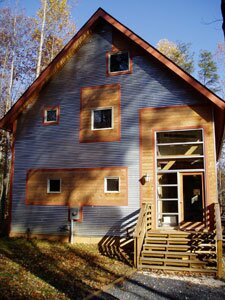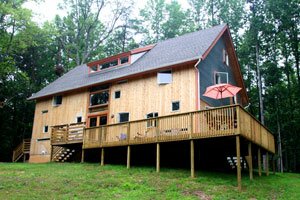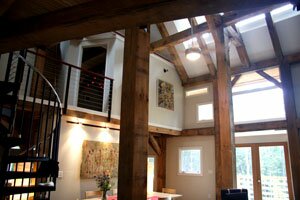REAL ESTATE- ON THE BLOCK- Eco-friendly: Nelson 'village' lures<span class="Apple-converted-space"> </span>conservationists
ADDRESS: 19 Old Turtle Place
NEIGHBORHOOD: Nellysford
ASKING: $430,000
COUNTY ASSESSMENT: $60,600 (Nelson's latest is 2003 land only)
YEAR BUILT: 2005
SIZE: 2,800 fin. sq. ft., 320 unfin.
LAND: 7.5 acres
CURB APPEAL: 8 out of 10
LISTED BY: Steven Braden of Montague Miller & Co., 760-2959
Irish poet William Butler Yeats was talking about someplace else when he said, "This is no country for old men," but his description applies totally to this property in Nelson County. From the steep rugged down-hill drive to a spiral staircase leading to not one but three lofts, the place is fit only for a young, energetic owner.
And a "green" energetic owner at that: the house is part of a development called "Horizons Ecovillage," a 200-acre compound near Nellysford reserved for environmentally aware residents. Of the 50 lots (of 5-10 acres each), 12 have been sold, and the houses all share a commitment to energy conservation and "green" construction.
This house, designed and built by an architect friend of the current owner, is a perfect example of what the Ecovillage developers must have had in mind. The exterior is a combination of western red cedar siding and galvanized steel. Inside, the eastern white pine timber-frame construction features insulated panels in the walls, creating maximum energy efficiency.
The open timber framing was intended to be rustic, and, to accentuate the impression of a barn, the architect designed a series of long narrow windows on three sides that admit light at slanting angles the way sunbeams filter through spaced timbers above milking parlors and hay lofts. While charming and creative, the effect, unfortunately, is more aesthetic than practical, as much of the back (north) side of the house is dark.
As compensation, large windows and six skylights (including one in a large front dormer) admit streaming light from the south-facing side of the house, which not only brings cheer to the otherwise dim space but also provides passive solar heating via polished cement floors that absorb heat to radiate at night.
Additionally, a gas-fueled radiant hot-water heating system in floors and upstairs walls (managed by a giant panel in the half basement) is part of an "Earthstar" geothermal system that also provides water from deep in the earth to cool the place in summer. To our novice's eye, it looks as though few, if any, energy-saving/conserving elements have been overlooked here.
The interior space is beautifully designed. A wide entrance hall leads to a huge, three-story "great room" whose main feature is the massive beams, all joined with wooden pegs (there are no nails in any of the framing). Wide tongue-and-groove floors in all rooms except the two full baths (which are tiled) and the cement-floored great room have been painted a fleshy salmon color. That paint choice seemed odd at first, but it grew on us as we got used to the house.
Behind the great room is an unusual sunken living room, another initially jarring element– somehow a canonical design staple of the '60s doesn't quite fit our idea of a post-and-beam ecohouse– but like the salmon floors, it came to seem more comfortable the longer we were there. Unfortunately, because it's out of view of the big windows, this space, like the kitchen on the opposite side of the big middle room, is dark, and being "sunken" only intensifies the impression of gloom.
The kitchen is functional, with the nice floors and stainless appliances. Light birch cabinets do what they can to brighten the space, but it's an uphill battle with only a tiny window over the sink. A hall with large coat closet beside the kitchen leads to a half bath.
On the second level loft are three bedrooms of roughly equal size. The one over the front door and entry hall has angled walls, adding a little interest to otherwise prosaic space. Off this bedroom is a full bath with claw-foot tub outfitted with a "shower kit," a conscious choice of the builder and owner, but one that may seem odd to new-home shoppers accustomed to every possible bathroom amenity. (There's a twin second full bath on this level for the other two bedrooms, likewise sans shower.)
Up ladders on each side of the loft are two more spaces– not technically rooms, but they're so high above the activity of the house on the main level that privacy would not be an issue if they were needed as bedrooms. Currently the owner uses one as an office and the other as a play area for children.
A deck surrounds the house on two sides and is no doubt a lovely spot for entertaining or dining or just frolicking about in good weather. Most of the acreage is in hardwoods; there's no other landscaping than what nature provides.
Membership in the "ecovillage" includes use of 100 acres of common area bordering the Rockfish River.
For a young couple or family with a care for the environment– and four-wheel drive vehicle– this could be a sweet find. But except for a few folks who want to work from home, squaring the eco-friendly aspects of life in the wilds of Nelson County with the fuel needed to motor to and from it seems to create something of a contradiction.



Photos courtesy of the owner